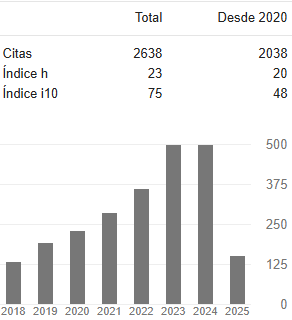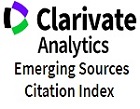Diseño de un modelo de auto-organización para la solución de las crisis en las organizaciones empresariales
DOI:
https://doi.org/10.31908/19098367.3269Palabras clave:
auto-organización, adaptabilidad, complejidad, crisisResumen
Las crisis empresariales son situaciones previsibles debido al alto nivel de sistemas interdependientes que caracterizan el entorno. La corriente de pensamiento dominante para la gestión empresarial se ha enfocado en prevenir las crisis a partir de la identificación de relaciones causales entre las variables del sistema; sin embargo a la fecha no ha generado los resultados esperados. Las ciencias de la complejidad han planteado que la mejor alternativa para superar las crisis, es la adaptabilidad del sistema a través la auto-organización; sin embargo en el contexto empresarial la investigación se encuentra en etapas tempranas y no existen modelos y/o evidencias empíricas que permitan corroborar la fuerza de estas ideas. El artículo propone el diseño de un modelo para la auto-organización empresarial que permita superar las crisis. La propuesta genera implicaciones respecto a nuevas vías para la gestión de las organizaciones empresariales, y en especial para la solución de las crisis.
Descargas
Referencias
Thom, R. Estabilidad Estructural y Morfogénesis: Ensayo de una Teoría General de Los Modelos. Barcelona: Editorial Gedisa S.A.1977
Helbing, D. Globally networked risks and how to respond. Nature, (497), pp. 51-59, 2013. http://dx.doi.org/10.1038/nature12047
Bak, P., Tang, C., and Wiesenfeld, K. Self-organized criticality. Phisycal Review, 38(1), pp. 364-373, 1988. http://dx.doi.org/10.1103/PhysRevA.38.364
Gershenson, C. Design and control of self-organizing systems. CopItarXiv:nlin/0603045V2. 2007.
Bonabeau, E., Theraulaz, G., Deneubourg, J. L., Aron, S., & Camazine, S. Self-organization in social insects. Trends in Ecology and Evolution, 12(5), pp. 188-193, 1997. http://dx.doi.org/10.1016/ S0169-5347(97)01048-3
Camazine, S., Deneubourg, J., Franks, N., Sneyd, J., Theraulaz, G., and Bonabeau, E. Sel-organization in biological system. United Kingdom, Pricenton University Press. 2003.
Watts, D. Seis grados de separación. La ciencia de las redes en la era de acceso. Barcelona, Paidos, Iberica, S.A. 2006.
Di Marzo Serugendo, G., Gleizes, M.-P., & Karageorgos, A. Selforganising Software: From natural to Artificial Adaptation. Springuer. 2011.
Bonabeu, E., Dorigo, M., & Theraulaz, G. Swarm Intelligence: From natural to artificial system. New York, Santa Fe Institute- Studies in the sciences of complexity. 1999.
Biancani, S. M., Daniel A., and Dahlander, Linus. The Semiformal Organization. Organization Science, 25(5), pp. 1306-1334, 2014. http://dx.doi.org/10.1287/orsc.2013.0882
Aime, F., Humprey, S., Derue, S., and Jeffrey, P. The riddle of heterarchy: power transitions in cross-functional teams. Academy of Management Journal, 57(2), pp. 327-352, 2014. http://dx.doi.org/10.5465/amj.2011.0756
Canales, R. Weaving Straw into Gold: Managing Organizational Tensions Between Standardization and Flexibility in Microfinance. Organization Science, 25(1), pp. 1-28, 2015. http://dx.doi. org/10.1287/orsc.2013.0831
Donal Crilly, P. Autonomy or Control? Organizational Architecture and Corporaten Attention to Stakeholders. Organization Science, pp.1-17, 2013.
Turnbull, S. A New Way to Govern: Organisations and society after Enron. London, New Economics Foundation. 2002
Alberts, D. and Hayes, R., Power to the edge: Command, control in the information age. Washington CCRP, 2003.
Mitleton-Kelly, E., and Puszczynski, L., An Integrated Methodology to Facilitate The Emergence of New Ways of Organising’ in Unifying Themes in Complex Systems. NECSI Knowledge Press, V. 2005.
Holland, J. Hidden Order: How Adaptation Builds Complexity. 1995.
Gershenson, C. The Implications of Interactions for Science and Philosophy. Foundations of Science, 18(4), pp. 781-790, 2011. http://dx.doi.org/10.1007/s10699-012-9305-8
Wilensky, U. NetLogo. From Center for Connected Learning and Computer-Based Modeling. Northwestern University, Evanston, IL. 1999.
Grider, R., and Wilensky, U. NetLogo Paths model. From Center for Connected Learning and Computer-Based Modeling, Northwestern University, Evanston, IL. 2015.
Stonedahl, F. and Wilensky, U. NetLogo Virus on a Network model., from Center for Connected Learning and Computer-Based Modeling, Northwestern University, Evanston, IL, 2008.
Espinosa, A., and Porter, T. Sustainability, complexity and learning: insights from complex systems approaches. Learning Organization, 18, pp. 54 – 72, 2011.
Bohórquez, L., and Espinosa, A. Theoretical approaches to managing complexity in organizations: A comparative analysis. Estudios Gerenciales (31), pp. 20-29, 2015.
Bedau, M., McCaskill, J., Packard, N., and Rasmussen, S.Living Technology: Exploiting Life’s Principles in Technology. Artificial Life, 16(1), pp. 89-97, 2010. http://dx.doi.org/10.1162/ artl.2009.16.1.16103
Martinoli, A. Collective Complexity out of Individual Simplicity. Artificial Life, 7(3), pp. 315-319, 2001.
Allen, P., Maguire, S., and McKelvey, B. The Sage Handbook of Complexity and Management. London, Sage Publications Ltd, 2011.
Bohórquez, L. E. Sistemas de control estratégico y organizacional: críticas y desafíos. Revista Ciencias Estratégicas, 19(26), pp. 307- 322, 2011.
Maldonado, C. Lo opuesto a la belleza no es lo feo. (Online) http://www.revistamilmesetas.com, 2013.
Barabási, A.-L. Bursts: the hidden patterns behind everything we do, from your email to bloody crusades. New York, Penguin Books Ltd. 2010.
Barabási, A., and Albert, R. Emergence of Scaling in Random Networks. Science, 286(5439), pp. 509-512, 1999.
Nicolis, G., and Prigogine, I. La estructura de lo complejo: en el camino hacia una nueva comprensión de las ciencias. México, Alianza Editorial, 2007.
Gould, S. J. La estructura de la teoría de la evolución. Barcelona, Metatemas, 2010.
Lorenz, E. Deterministic nonperiodic flows. Journal of the atmospheric sciences, 20, pp. 130-141, 1963. http://dx.doi.org/10.1175/1520-0469(1963)020%3C0130:DNF%3E2.0.CO;2
Wang, X.-T. Introduction: Bounded rationality of economic man: New frontiers in evolutionary psychology and bioeconomics. Journal of Bioeconomics (3), pp. 83-89, 2001. http://dx.doi.org/10.1163/9789004228252_002
Tihanyi, L., Graffin, S., and George, G. Rethinking governance in management research. Academy of Management Journal, 1015(1), pp. 1-9, 2015. http://dx.doi.org/10.5465/amj.2014.4006
Mitleton-Kelly E., Ed., Complex Systems and Evolutionary Perspectives on Organisations. The application of Complexity Theory to Organisations. London, London School of Economics, 2003.
Kleinbaum, A., Stuart, T., and Tushman, M. Discretion Within Constraint: Homophily and Structure in a Formal Organization. Organization Science. 24(5). pp 1316-1336, 2015. http://dx.doi.org/10.1287/orsc.1120.0804
Nahapiet J, G. S. Social capital, intellectual capital, and the organizational advantage. Academy Management of Journal, 23(2), pp. 242-266, 1998. http://dx.doi.org/10.2307/259373
Ouchi, W. Markets, Bureaucracies, and Clans. Administrative Science Quarterly, 25(1), pp. 129, 1980
Adler, P. (2001). Market, hierarchy, and trust: The knowledge economy and the future of capitalism. Organization Science, 12, pp. 215-234, 2001. http://dx.doi.org/10.1287/orsc.12.2.215.10117
Axelrod, R. The evolution of cooperation. New York, Basic Books, 2006.
Murmann, J. P. The Coevolution of Industries and Important Features of Their Environments. Organization Science, 24(1), pp. 58-78, 2013. http://dx.doi.org/10.1287/orsc.1110.0718
Escoffier, N., and McKelvey, B. (2015). The Wisdom of Crowds in the Movie Industry: Towards New Solutions to Reduce Uncertainties. International Journal of Arts Management, 17(2), pp. 52-63, 2015.
Xiaoyong Tian, H. J., Jin Zha., and Linlin Li. Study on industrial cluster knowledge emergence model based on asymmetric influence In G. C. Wei Lu, Weibin Liu,Weiwei Xing (Ed.), Proceedings of the 2012 International Conference on Information Technology, 2012. pp.67.
Andriani, P., and McKelvey, B. From Skew Distributions to Powerlaw Science, in Allen, P., Maguire, S., & McKelvey, B. The Sage Handbook of Complexity and Management. London, SAGE Publications Ltd. 2011. Pp.254-273, 2011.
Andriani, P., and McKelvey, B. From Gaussian to Paretian Thinking: Causes and Implications of Power Laws in Organizations. Organization Science, 20(6), pp. 1053-1071, 20009. http://dx.doi.org/10.1287/orsc.1090.0481
Ramos, R. S., R; Piqueira, J. Self-organized criticality and the predictability of human behavior. New Ideas in Psychology, 29(1), pp. 38-48, 2011. http://dx.doi.org/10.1016/j.newideapsych.2009.12.001
Cook, W., Ormerod, E., & Cooper. Scaling bahaviour in the number of criminal acts commited by individuals. Journal of Statistical Mechanics: Theory and Experiment (JSTAT)(7), P07003, 2004.
Collins, J., & Porras, J. Empresas que perduran: Principios exitosos de compañías triunfadoras. Bogotá, Norma, 2002.
Axelrod, R., and Cohen, M. Harnessing Complexity. United States of America, Basic Books, 2000.
Emmeche, C. Vida Simulada en el Ordenador. Barcelona, Gedisa editorial, 1998.
Boisot, M., and Mckelvey, B. Integrating Modernist and Postmodernist Perspectives on Organizations: A Complexity Science Bridge. Academy of Management Review, 35(3), pp. 415-433, 2010. http://dx.doi.org/10.5465/AMR.2010.51142028
Maldonado, C., and Gómez, N. Modelación y simulación de sistemas complejos. Bogotá, Universidad del Rosario, 2010.
Carvajal, Y. Efectos de la variabilidad climática (vc) y el cambio climático (cc) en los recursos hídricos de Colombia. Entre Ciencia e Ingeniería (9), pp 33-61, 2011.
Descargas
Publicado
Número
Sección
Licencia
Derechos de autor 2019 Entre Ciencia e Ingeniería

Esta obra está bajo una licencia internacional Creative Commons Atribución-NoComercial 4.0.



















